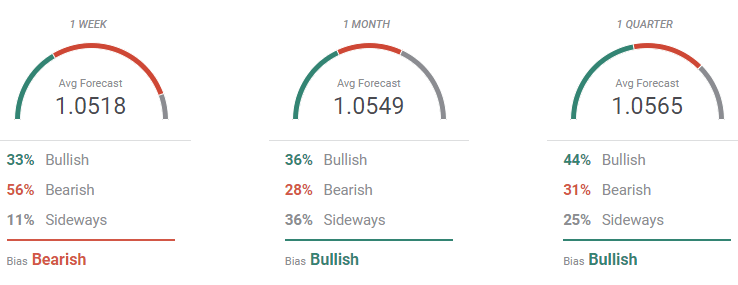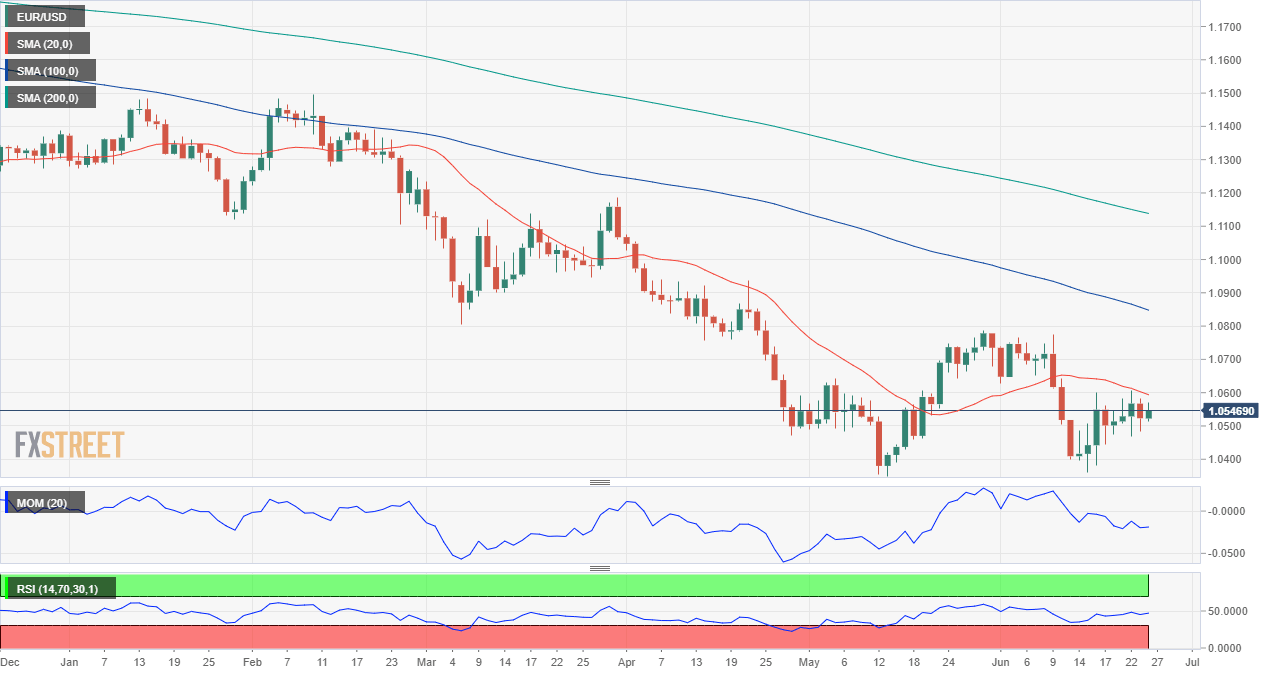EUR/USD Weekly Forecast: Economic tsunami catching policymakers off guard
- Fresh signs of economic slowdown exacerbate recession-related fears.
- Central bankers may be cautious or aggressive, but anyway can do little about energy and food prices.
- EUR/USD's long-term bearish stance remains intact, spikes will likely be seen as selling opportunities.

The EUR/USD pair managed to recover some ground after bottoming mid-June at 1.0358, finishing the week a handful of pips above the 1.0500 threshold. The advance was tepid, as sellers continued to defend the upside around 1.0600.
Over the last couple of months, the previous inflation-related concerns materialized into recession fears. Central banks spent years feeding markets liquidity and were cough off guard by the pandemic, early in 2020. The subsequent stall in economic activity and the slow comeback to normal had unexpected effects, in which inflation became the most notorious.
How did we get here?
The booming economic recoveries after the first year of the pandemic slowed down amid supply-chain issues. The world machine is too big and too complex to resume activity in a few months. Slowing growth was also an unexpected event. And to top it all, Russia decided to invade Ukraine, while the rest of the world came out with economic sanctions on Moscow and its allies. The economic turmoil is out of control. Politicians and central bankers are well aware of it and are doing what they can, which by the way, is far from enough to keep the financial boat afloat.
Hiking rates will help taming price pressures, but at the same time, will affect consumption, which in turn will translate into slower economic growth. Recession and stagflation are the new words that dictate market behavior.
Not market-related, the people stand in the way, but that’s not a priority for policymakers, regardless of what they might say. Expensive energy, food prices and shortages are reaching levels of concern, and monetary policy measures are doing little to control them.
Central bankers looking the other way
Even further, US Federal Reserve Chair Jerome Powell was clear about their incapability to take some prices down. Testifying before Congress on Monetary Policy and the State of the Economy, Powell noted that the central bank has little control over energy and food prices, although he repeated their unconditional commitment to fighting inflation. The central bank’s leader finally added that it is “significantly more challenging” to bring down inflation without impacting the labor market. Nevertheless, the Fed is comfortable with the current pace of rate hikes, and markets anticipate another 75 bps move for July, followed by a series of at least, 50 bps hikes. US policymakers are firmly stuck to their aggressive stance.
On the other hand, the European Central Bank is among the most cautious. Most major central banks have pulled the trigger more than once, but the ECB is planning to hike rates by 25 bps in July. Still, European moderation is doing no better than US aggressiveness. The situation in the Union, due to tensions with Russia and the shortage of energy resources, is set to worsen.
German Economy Minister Robert Habeck announced the country would move to stage two of its three-stage gas plan amid reduced Russian flows. Ever since the war began in Ukraine, fuel shortages have been Europe's main concern. This particular phase does not mean state intervention, but the country is getting close to that.
Inflation and growth to remain in the eye of the storm
Against this backdrop, it seems quite unlikely that the shared currency could gather sustainable bullish momentum. The FX board is more of dollar’s dynamics at a certain time and with a certain sentiment than euro-sided factors.
Data-wise, inflation-related figures kept indicating price pressures, while growth-related ones signalled slowing progress. The German Producer Price Index jumped to 33.6% YoY in May, while the flash S&P Global PMIs indicated a sharp slowdown in businesses activity at the end of the second quarter, in the US and the EU.
The next week will include some data of relevance, which will likely paint the same economic reality. On Monday, the US will publish May Durable Goods Orders, seen up a modest 0.1% MoM. On Wednesday, Germany will release the preliminary estimates of the June Consumer Price Index, while the US will unveil the final estimate of the Q1 Gross Domestic Product. Germany will publish May Retail Sales, while the US will release core PCE inflation figures afterwards, and the EU will offer the preliminary estimates of June inflation data. Finally, ECB’s President Christine Lagarde will be on the wires throughout the week.

EUR/USD technical outlook
From a technical point of view, the long-term bearish trend remains intact. The pair is developing well below a descendant trend line coming from this year’s high at 1.1494, currently at around 1.0650. The weekly chart shows that the pair stands below all of its moving averages, with the 20 SMA heading firmly south roughly 300 pips above the current level. Technical indicators, in the meantime, remain within negative levels, although without clear directional strength.
In the daily chart, technical readings indicate that bears retain control of EUR/USD. The 20 SMA capped the upside for a second consecutive week, gaining bearish strength below the longer ones. Technical indicators, on the other hand, lack directional strength but hold within negative levels.
The pair spent the week in consolidative mode, with sellers aligned around the 1.0600 level. A break above the aforementioned trend line could result in a bullish correction towards the 1.0780 price zone, where the pair hit its monthly high in May. Bears will be concerned if the pair establishes itself above the latter.
Initial support comes at around 1.0460, followed by the 1.0390 area. A stronger support level is 1.0339, the low from January 2017, with a break below it opening the door for a test of parity.
EUR/USD sentiment poll
The FXStreet Forecast Poll suggests that the EUR/USD pair will remain under pressure in the near term, although some polled experts speculate about a potential bottom and a marginal recovery afterwards. Those betting for a recovery in the monthly and quarterly perspectives overcome bears by little, and represent less than 50%, putting at doubt a firmer recovery.
The Overview chart shows that the near-term moving average turned marginally higher, although the pair is seen confined to the 1.0400/600 range. The longer moving averages are aiming marginally higher, but their strength is limited. What is notable, is that the number of those betting for higher levels has increased. Nevertheless, there are still some analysts eyeing a possible approach to parity by the end of the third quarter.

Premium
You have reached your limit of 3 free articles for this month.
Start your subscription and get access to all our original articles.
Author

Valeria Bednarik
FXStreet
Valeria Bednarik was born and lives in Buenos Aires, Argentina. Her passion for math and numbers pushed her into studying economics in her younger years.


















